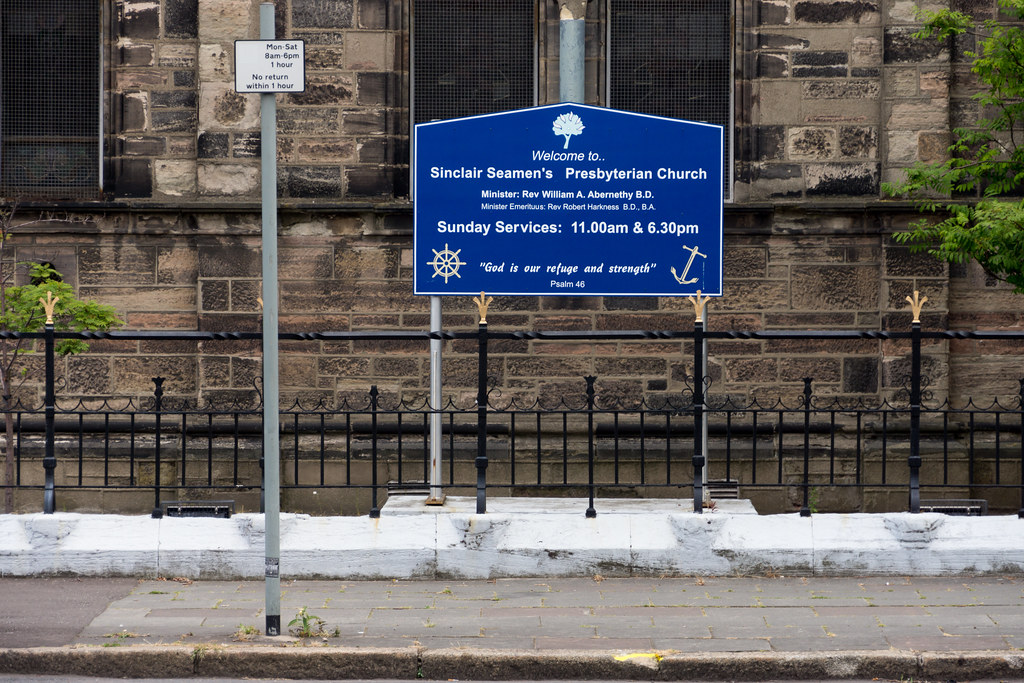Sinclair Seamen's Presbyterian Church
Sinclair Seamen's church is located in the dockland area of Belfast known as Sailortown.
Sailortown was a working-class dockland community located in the Docks area of Belfast, Northern Ireland. Established in the mid-19th century on partly reclaimed land, it had a mixed Protestant and Catholic population.
The 1907 dock strike called by trade union leader James Larkin commenced in Sailortown before spreading throughout the city.
Urban redevelopment in the late 1960s resulted in Sailortown's eventual demolition; only two churches, several pubs, and three houses remain of the once bustling waterfront enclave.
The 1907 dock strike called by trade union leader James Larkin commenced in Sailortown before spreading throughout the city.
Urban redevelopment in the late 1960s resulted in Sailortown's eventual demolition; only two churches, several pubs, and three houses remain of the once bustling waterfront enclave.
Sinclair Seamen's Presbyterian Church, located in Corporation Street. The maritime-themed church was commissioned by Thomas Sinclair and built in 1856 by architect Charles Lanyon.
Sailortown was situated in the Docks area north of Belfast city centre roughly bordered by Henry Street, York Street and the Whitla Street dock gate. It was adjacent to the old York Road railway station. Garmoyle Street served as Sailortown's main arterial road, and at one time over 5,000 people lived in the small, cobblestoned streets of red-brick terraced houses packed between the docks and York Street. Visiting sailors from many European nations (in particular those bordering the Baltic Sea) and from even as far away as India and China added to the resident population, which was mixed Protestant and Catholic.
People from all over the island of Ireland settled in Sailortown, including many who were left destitute during the Irish potato famine. The late 19th century saw the arrival of many Italian immigrants; this community, known as "Little Italy", was largely based around Little Patrick Street at the southern end of Sailortown.
The maritime-themed Sinclair Seamen's Presbyterian Church and St. Joseph's Chapel, a Roman Catholic church served as the places of worship for the Sailortown populace. Sinclair Seamen's church is still standing on Corporation Street as is St Joseph's, built in 1880 on Princes Dock Street. St Joseph's however is no longer in use, having been closed by the Diocese of Down and Connor in 2001 due to falling attendances and the lack of a local community. Plans for a restoration of the church have been mooted, albeit without any concrete details revealed.
People from all over the island of Ireland settled in Sailortown, including many who were left destitute during the Irish potato famine. The late 19th century saw the arrival of many Italian immigrants; this community, known as "Little Italy", was largely based around Little Patrick Street at the southern end of Sailortown.
The maritime-themed Sinclair Seamen's Presbyterian Church and St. Joseph's Chapel, a Roman Catholic church served as the places of worship for the Sailortown populace. Sinclair Seamen's church is still standing on Corporation Street as is St Joseph's, built in 1880 on Princes Dock Street. St Joseph's however is no longer in use, having been closed by the Diocese of Down and Connor in 2001 due to falling attendances and the lack of a local community. Plans for a restoration of the church have been mooted, albeit without any concrete details revealed.
The Midlands Hotel, on York Street, was once known as one of Belfast's most prestigious hotels. Notable guests included Laurel and Hardy and 1960s singer P. J. Proby.
SORRY FOR THE DELAY


